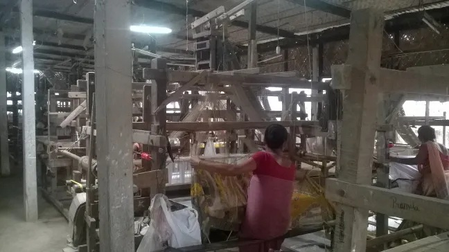New Delhi, 14 April (IANS). India’s raw silk production has recorded a strong growth and in the last six years the production has increased to 38,913 MT (MT) in FY 2023-24, which was 31,906 MT in FY 2017-18.
According to government data, due to this increase, mulberry gardens are expanded, which has increased to 2,63,352 hectares in FY 2023-24. The figure was 2,23,926 hectares in the financial year 2017-18. Due to this, the production of mulberry silk has increased from 22,066 MT in 2017-18 to 29,892 MT in 2023-24.
The total raw silk production increased from 31,906 MT in 2017-18 to 38,913 MT in 2023-24. Export of silk and silk items increased from Rs 1,649.48 crore to Rs 2,027.56 crore in 2023-24 in 2017-18.
According to the government report, the country has exported 3,348 metric tons of silk waste in 2023-24.
The production of raw silk is estimated to be 34,042 metric tonnes during the April-January period of 2024-25, which is about 10,000 tonnes higher than the 24,299 metric tonnes of the same period of 2014-15.
India is the second largest producer of silk and also the largest silk consumer in the world. Mulberry silk in India is produced mainly in the states of Karnataka, Andhra Pradesh, Tamil Nadu, Jammu and Kashmir and West Bengal, while non-shatter silk is produced in Jharkhand, Chhattisgarh, Orissa and North-Eastern states.
Mulberry comes from silk silk insects that only eat mulberry leaves. It is soft, smooth and shiny, which makes it the perfect product for luxury sarees and high-end clothes. About 92 percent of the country’s total raw silk production comes from mulberry.
Non-proclaimed silk (also known as Vanya silk) comes from wild silk insects that eat leaves of trees like oak, castor and Arjuna. This silk is a natural, soil -like feeling with low glow but it is strong, durable and environmentally friendly.
Government schemes have an important role in the development of silk industry in India. These initiatives provide financial assistance and resources for various activities related to silk production.
The ‘Resham Samagra’ scheme is an important initiative of the government to improve the silk production industry across India. It aims to increase production by improving quality and productivity and empowering the deprived, poor and backward families through various activities of silk production in the country.
‘Resham Samagra-2’ is an expansion of this attempt, whose budget is Rs 4,679.85 crore for a period from 2021-22 to 2025-26.
So far, central assistance of Rs 1,075.58 crore has been provided, which has benefited more than 78,000 people. According to government data, financial assistance has been given to Andhra Pradesh (Rs 72.50 crore) and Telangana (Rs 40.66 crore) in the last three years to assist industries in ‘Resham Samagra-2’.
-IANS
ABS/
